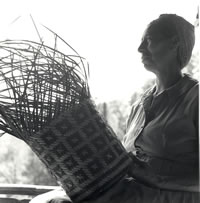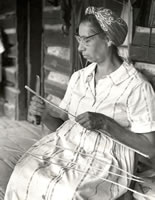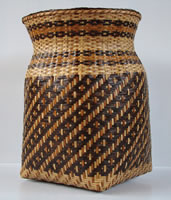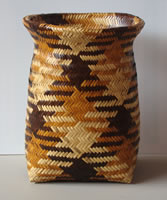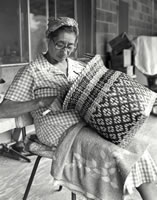People: Eva Wolfe
Living and working in the Big Cove community northeast of Cherokee, Eva Wolfe (1922-2004) was a master basket weaver who specialized in baskets made from rivercane. Over the course of her lifetime, Wolfe won many local and national awards recognizing her work. These awards included numerous prizes in competitions at annual fairs held on the Qualla Boundary as well as awards from the North Carolina Folklore Society, National Endowment for the Arts, and the US Department of the Interior.
Eva Wolfe was born in 1922 in Soco, a remote community on the eastern edge of the Qualla Boundary. As a young girl, she learned to make baskets from her mother. While Wolfe was still in high school, her aunt, Lottie Queen Stamper, began to teach basket weaving at the Cherokee Indian School. Wolfe studied rivercane basketry with Stamper and, after high school, attended adult education classes. In the late 1950s, when she was in her mid 30s, Wolfe “realized that there were only two older basket weavers who could do rivercane double weave baskets.” This idea led her to focus on this difficult tradition so that “it might be retained for future generations of Cherokee craftworkers.” 1
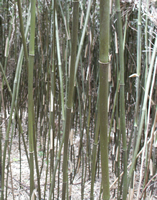
Rivercane must be
harvested and split
In a 1988 interview published in the North Carolina Folklore Journal, Wolfe explained how basket making fit into her life. Like other traditional craftworkers, Wolfe made baskets as part an entire matrix of domestic activity. Raising a large family, Eva Wolfe integrated child rearing, gardening, housekeeping, and artistry. Her basket making was woven into a lifestyle of day-to-day responsibilities that provided support for 11 children.
To make her baskets, Wolfe used rivercane, a native plant that once grew abundantly along the region’s riverbanks. Every spring Eva Wolfe and her husband, Amble, drove 80 miles to Hayesville, North Carolina, where they gathered rivercane, cutting it by hand with a bush knife. A truckload of cane was enough material to last her several months. Before the cane could be used to make a basket, it had to be prepared. Wolfe used a hunting knife and pocketknife to scrape the cane and split it lengthwise into strips. Each stalk yielded four splits for weaving; Wolfe used approximately 120 strips to weave a single basket. Wolfe explained her preference for rivercane in this way: “I prefer rivercane as a basket weaving material because of the patterns I can see in the weaving.” 2
The pattern Wolfe referred to is from dyes derived from native plants. Wolfe and her husband gathered native plants to use as dye materials. Like many other Cherokee basket weavers, Wolfe used bloodroot to create a reddish-brown color and the roots of the butternut tree for a dark brown. In summer, she soaked the dyestuffs outdoors in a washtub; in winter she used a large cooking pot set onto the family’s woodstove. An interviewer concluded, “All told, gathering, preparing, and dying the raw materials can account for half the time Wolfe need to create a basket.” 3
Wolfe wove rivercane baskets using both the single weave and double weave techniques. She won many awards at the annual Cherokee Fair. In 1968 her work placed first in an exhibit sponsored by the US Department of the Interior. In December 1969, the Indian Arts and Crafts Board and Qualla Arts and Crafts artisan cooperative organized a display of 18 of Wolfe’s baskets for an exhibition. That same year, she won first prize from the US Department of the Interior for a double weave rivercane basket and her work was shown at the Renwick Gallery, part of the Smithsonian Institution. In 1977 she was awarded a grant from National Endowment for the Arts that helped her “secure materials for more baskets.” In 1980 her work was part of an inaugural exhibition at the Appalachian Center for Crafts in Tennessee. In 1988 she was awarded the Brown-Hudson Folklore Award from the North Carolina Folklore Society. 4 The following year she received a Heritage Award from the North Carolina Arts Council.
Anna Fariello
Excerpted from Cherokee Basketry: From the Hands of our Elders,
Published by The History Press, 2009
1. Mollie Blankenship and Stephen Richmond. Contemporary Artists and Craftsmen of the Eastern Band of Cherokee Indians: Promotional Exhibits, 1969-1985 (Cherokee, NC: Qualla Arts and Crafts Mutual, Inc, 1987) 2.
2. Mollie Blankenship, “Eva Wolfe: Traditional Basketweaver,” North Carolina Folklore Journal 35, no. 2 (summer-fall 1988) 95; “A Treasury of Tar Heel Folk Artists: The North Carolina Folk Heritage Award, 1989-1996,” North Carolina Folklore Journal 44, no. 1-2 (1997) 17; Arlene Hirschfelder, American Indian Lives: Artists and Craftspeople (New York: Facts on File, 1994), 82.
3. Blankenship, “Eva Wolfe,” 95; Hirschfelder, 85-86.
4. Blankenship, Contemporary Artists, 2; Blankenship, “Eva Wolfe,” 95; Hirschfelder, 88.

